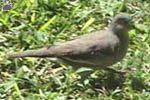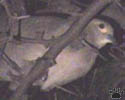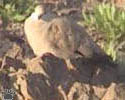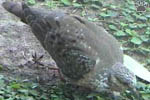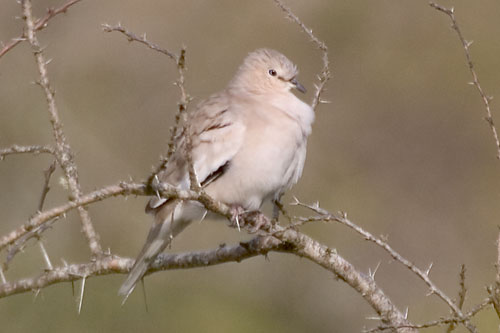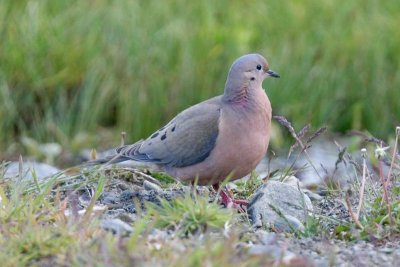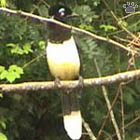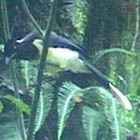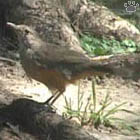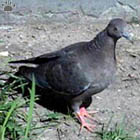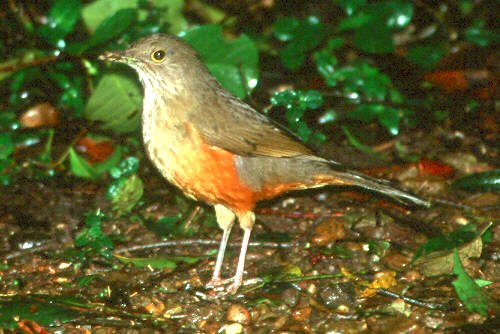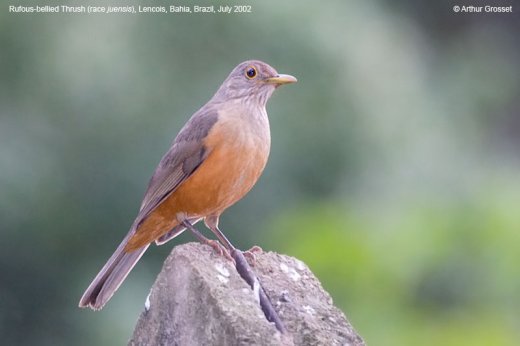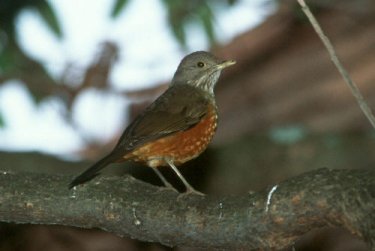|
From
a rearranged translation of Vladimir
Dinets original pages to norwegian,
with supplements.

Klikk på flagg for norsk versjon
Pages for Latin America
The Argentinian Andes
The Andes of Argentina are not as spectacular and diverse as the
mountains of Chile and Peru,
but there are many beautiful places worth visiting.
|
|
|
|
Views
from the summit of Cerro Aconcagua.
|
Cerro Aconcagua is the highest peak outside Asia.
It is relatively easy to climb: you can hike to the summit and back
in three days or less if you tolerate altitude well.
Most people need a few more days for acclimatization.

Summit of Cerro Aconcagua.. |

Ice formations on the slopes of
Cerro Aconcagua |
Another beautiful place is Parque Nacional Los Cardones near Salta,
famous for its forests of giant cacti, and for puna wildflower blooms
in summer.

Los Cardones NP. |

Los Cardones NP. |
Los Cardones National Park in Northwest Argentina is home to
thousands of massive succulents. and is a great stop on a day
trip from Salta. The cordone cacti number in the many
thousands in this 130,000 acre park. They are stately and massive.
Los Cardones National Park is located in the central western
part of the Salta Province, between the designated Calchaquíes
Valleys. The terrain consists of the typical sierras and dry
gorges between 2700 and 5000 m above sea level, where bushes
and "cardones" or thistles, Trichocereus pasacana,
make up the abundant vegetation
that grows there.
|
 Trichocereus
pasacana
(?)
Trichocereus
pasacana
(?)
Source:
http://www.travelmedianinja.com/?p=2129 |
Wildlife of Los Cardones and other puna areas includes guanacos,
condors, rheas, tinamous, pumas,
and an impressive variety of small birds and rodents. Seeing it requires
patience and a lot of hiking around.
Andean
Hairy Armadillo, Chaetophractus nationi

Hairy armadillo,
Chaetophractus nationi,
PN Los Cardones. |

Kissing
bug, Rhodnius,
vector of Chagas' disease,
PN Los Cardones. |
The Andean Hairy Armadillo, Chaetophractus
nationi, is an armadillo present in Bolivia, in the
region of the Puna, the departments of Oruro, La Paz, and Cochabamba,
also distributed in Bolivia and northern Chile.
A recent publication also locates the species in Peru. It is
also thought to be present in northern Argentina.
 An
Andean hairy armadillo, Chaetophractus nationi, in Oruro,
Bolivia.
An
Andean hairy armadillo, Chaetophractus nationi, in Oruro,
Bolivia.
Photo:
Guido Valverde |
|
Big
Hairy Armadillo, Chaetophractus villosus
|
Big Hairy Armadillo, Chaetophractus villosus,
of the family Dasypodidae, is one of the largest and
most
numerous armadillos in South America. It lives from sea level
to altitudes of up to 1,300 meters across the
southern portion of South America and can be found in grasslands,
forests, savannahs, and has even started
claiming agricultural areas as its home. It is an accomplished
digger and spends most of its time below ground.
|
|
|
|
|
|
Andean
hairy armadillo, Valle de la Luna.
|
They make both temporary and long term burrows depending on
their food source. The armadillo can use specially evolved
membranes in its nose in order to obtain oxygen from the surrounding
soil particles without inhaling any
of the soil itself. Armadillos are protected from predators
by a series of thin bony plates along the head and back.
 Large
hairy armadillo - overview
Large
hairy armadillo - overview
BBC
Natural History Unit & Granada Wild
www.arkive.org
|
They reach sexual maturity at around nine months and have
been known to live over thirty years in captivity.
Though this animal is routinely harvested for its meat and
its shell, or simply killed for pestering farmers, it has
shown amazing resiliency and populations seem to be handling
this exploitation well.
|
Kissing
bugs
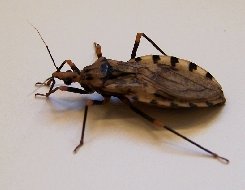 Panstrongylus
geniculatus
Panstrongylus
geniculatus
Photo:
Fernando Otálora Luna |
Kissing bugs, members of Triatominae,
a subfamily of Reduviidae, are also known as conenose
bugs, assassin
bugs or triatomines. Most of the 130 or more species
of this subfamily are haematophagous, i.e. feed on vertebrate
blood; a very few species feed on other invertebrates. They
are mainly found and widespread in the Americas,
with a few species present in Asia, Africa and Australia. These
bugs usually share shelter with nesting vertebrates,
from which they suck blood. In areas where Chagas disease occurs
(from the southern United States to southern
Argentina), all triatomine species are potential vectors of
the Chagas disease parasite Trypanosoma cruzi, but only
those species (such as Triatoma infestans and Rhodnius
prolixus) that are well adapted to live with humans are
considered important vectors.
Chagas disease; Portuguese: doença de Chagas,
Spanish: enfermedad de Chagas-Mazza, mal de Chagas in both languages;
also called American trypanosomiasis) is a tropical parasitic
disease caused by the flagellate protozoan Trypanosoma cruzi.
Trypanosoma cruzi. is commonly transmitted to humans
and other mammals by an insect vector,
the blood-sucking insects of the subfamily Triatominae
(family Reduviidae) most commonly species belonging to
the
Triatoma, Rhodnius, and Panstrongylus genera.
The disease may also be spread through blood transfusion and
organ transplantation, ingestion of food contaminated with parasites,
and from a mother to her fetus. |
|
|
|
|
Puna
flowers, Los Cardones National Park.
|
Rufous-collared
Sparrow, Zonotrichia capensis

Andean sparrow,
PN Los Cardones. |

Andean sparrow, Zonotrichia capensis
The most widespread bird in The Andes.
|

Andean sparrow,
PN Los Cardones. |
The Rufous-collared Sparrow, Zonotrichia capensis,
is an American sparrow found in a wide range of habitats,
This member of bunting
family occurs in cities, towns, and pretty much everywhere
else in highlands from southern Mexico to Tierra del Fuego.In
Chile and Argentina, it lives all the way down to sea level.
On the Altiplano, it can be
seen at altitudes of up to 5,000 m.
It is famous for its diverse vocalizations, which have been
intensely studied since the 1970s. Local names for this bird
include the Portuguese tico-tico and the Spanish chingolo and
copetón (tufted) in Colombia.
 A
Chingolo, Zonotrichia capensis, in Provincia
de Pichincha, Ecuador
A
Chingolo, Zonotrichia capensis, in Provincia
de Pichincha, Ecuador
Photo:
Manuel Mejia |
The Rufous-collared Sparrow is 13.5–15 cm long and weighs
20–25 g. The adult has a stubby grey bill and a grey head
with broad black stripes on the crown sides and thinner stripes
through the eye and below the cheeks. The nape and
breast sides are rufous and the upperpart are black-streaked
buff-brown. There are two white wing bars. The throat is
white, and the underparts are off-white, becoming brown on the
flanks and with a black breast patch.
There are between 25 and 29 subspecies. In general, the smaller
forms occur in coastal mountains, intermediate birds
in the Andes, and large, darker, forms breed on the tepuis.
The Rufous-collared Sparrow feeds on the ground on seeds, fallen
grain, insects and spiders. It will sometimes join
mixed-species feeding flocks and has been observed to pick termites
from spider webs. It is usually seen in pairs which
hold small territories, or in small flocks. Tame and approachable,
it is common throughout its large range.
Source: http://en.wikipedia.org/wiki/Rufous-collared_Sparrow |
|
|
|
|
|
|
Doves
of the Argentinian Andes, left to right: Picui Dove, Columbina
picui,
Moreno's Ground-dove Metriopelia morenoi, Eared Dove,
Zenaida auriculata, immature Eared Dove.
|
Picui
Ground Dove, Columbina picui
The Picui Ground Dove, Columbina picui, is a
species of bird in the Columbidae
family. It is found in Argentina,
Bolivia, Brazil, Chile, Colombia, Paraguay, Peru, and Uruguay.
Its natural habitats are subtropical or tropical dry
shrubland, subtropical or tropical moist shrubland, subtropical
or tropical high-altitude shrubland, and heavily
degraded former forest.
 Moreno's
Ground Dove, Metriopelia morenoi
Moreno's
Ground Dove, Metriopelia morenoi
www.worldbirdguide.com
|
The Moreno's Ground Dove, Metriopelia morenoi,
is also a species of bird in the Columbidae family.
It is endemic to Argentina.
Its natural habitat is subtropical or tropical high-altitude
shrubland. It has the back brown and gray belly, and the
periocular orange, pinkish legs. |
Eared
Dove, Zenaida auriculata
The Eared Dove, Zenaida auriculata, is
a New World tropical dove. It is a resident breeder throughout
South
America from Colombia to southern Argentina and Chile, and on
the offshore islands from the Grenadines
southwards. It may be a relatively recent colonist of Tobago
and Trinidad. It appears to be partially migratory,
its movements driven by food supplies.
The Eared Dove is 24 cm long with a long wedge-shaped tail,
and weighs normally about 112 g. Adult males have
mainly olive-brown upperpart plumage, with black spots on the
wings. The head has a grey crown, black line
behind the eye, and the blue-black on the lower ear coverts.
These black markings give the species its English and
specific name. The underparts are vinous, and the tail is tipped
with cinnamon. The bill is black and the legs dark
red.
The female is duller than the male, and immatures are greyish-brown,
very dull, with pale barring.
The species' call is a deep soft oo-ah-oo.
Source:
http://en.wikipedia.org/wiki/Eared_Dove |
As you move north along the Argentinian side of the Andes,
the landscape rapidly changes from very dry to very wet.
Eventually, you get into yungas - the lush cloud forests of Northern
Argentina and Bolivia.

Unidentified flower
Parque Nacional Calilegua. |

Cerro Aconcagua. |

Unidentified flower
Parque Nacional Calilegua. |
|
|
|
|
Cloud
forests of PN Calilegua.
|
|
Birds
of Calilegua, upper row, left to right: Plush-crested Jay,
Cyanocorax chrysops, (2 photos),
Rufous-bellied Thrush, Turdus rufiventris, Picazuro
Pigeon, Columba picazuro;
bottom row: Slaty Elaenia, Elaenia strepera, Gold-olive
Woodpecker, Piculus rubiginosus,
White-troated Antpitta, Grallaria albigula
|
Plush-crested
Jay, Cyanocorax chrysops
The Plush-crested Jay, Cyanocorax
chrysops, is a jay of the
Corvidae family, which includes the crows and their many allies.
It is found in central-southern South America in southwestern
Brazil, Bolivia, Paraguay, Uruguay, and northeastern Argentina,
including southern regions of the Amazon Basin river systems,
bordering the Pantanal.
This is an elegant medium sized bird, dark plumaged with a
cream-yellow breast; the bulky tail is also cream colored, top
and underneath, for the lower half.
The range of the Plush-crested Jay extends from the Southern
Region, Brazil with Uruguay and approaches the South Atlantic
coast, but avoids the coast, approximating a 400 to 150 km
coastal strip; the coastal-inland range extends 3500 km from
São Paulo south to Rio Grande do Sul bordering Uruguay.
The inland range continues in northwestern Uruguay and extends
northwest through northern Argentina, Paraguay-Bolivia, and
through the pantanal at the southern cerrado; the range extends
in two arms, to the northwest to northern Bolivia, and north-
eastwards to headwaters of the Amazon Basin Tapajós River.
Source: http://en.wikipedia.org/wiki/Plush-crested_Jay
|
 Photo: David.Monniaux
Photo: David.Monniaux
|
Rufous-bellied
Thrush, Turdus rufiventris
The Rufous-bellied Thrush, Turdus rufiventris,
is a songbird of the thrush family Turdidae.
It occurs in most of east and southeast Brazil from Maranhão
south to Rio Grande do Sul states, Bolivia,
Paraguay, Uruguay and northern regions of Argentina.
It is one of the most common birds across much of southeastern
Brazil, and is well-known there under its local
name sabiá-laranjeira. The Rufous-bellied Thrush has
been the state bird of São Paulo since 1966.
It was proposed as the national bird of Brazil, and was officially
chosen in 2002.
|
This species is named after its distinctive reddish-orange
underparts. Rufous-bellied Thrushes can reach a length
of 25 cm and weigh up to 68 g (male) or 78 g (female), though
weights of about 59 g for males and 64 g for
females are more usual. Contrary to what one might expect from
the rather marked weight difference,
the females are not larger, only plumper; their tarsus is actually
a bit shorter than that of males on average.
Found in forests and urban wooded areas, it is an omnivorous
bird. Its food consists mainly of fruits and
arthropods, and it can sometimes be seen attending mixed-species
feeding flocks and moving through the bushes
with many other birds. It has been observed to squabble with
a Common Marmoset, Callithrix jacchus, in the
undergrowth over food flushed by an army ant column, but this
was during the dry season when fruits are scarce.
It builds an open-cup nest, sometimes right on the forest floor,
sometimes more than 20 meters high in a tree,
but usually 4–5 meters above ground. In the yungas of NW
Argentina, nesting occurred in the wet season from
October to March, with most birds breeding in November–December.
The three, sometimes two eggs measure
about 27-28 by 20 mm, and weigh c.5.7-5.9 grams each. They are
incubated for about 12–13 days, and young
take about that long again untlil they fledge.
Source: http://en.wikipedia.org/wiki/Rufous-bellied_Thrush |
Gold-olive
Woodpecker, Piculus rubiginosus
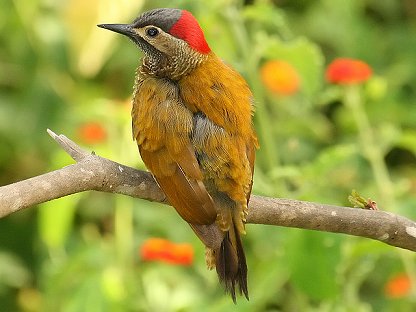 Gold-olive
Woodpecker, Piculus rubiginosus
Photo: http://www.flickr.com/photos/73738437@N00
Gold-olive
Woodpecker, Piculus rubiginosus
Photo: http://www.flickr.com/photos/73738437@N00
|
The Golden-olive Woodpecker, Colaptes rubiginosus,
is a resident breeding bird from Mexico south and east
to Guyana, northwest Argentina, Trinidad and Tobago. It was
formerly placed in the genus Piculus). The scientific
name rubiginosus means "full of rust", describing
the color of the bird's wings and back.
The habitat of this woodpecker is forests, more open woodland,
and cultivation. It is most common in the mountains.
Two or three white eggs are laid in a nest hole in a tree and
incubated by both sexes. The young are fed by regurgitation.
The Golden-olive Woodpecker is 22 cm long and weighs 68g. Adults
are mainly golden olive above with some barring on the tail.
The forecrown is grey, and the hindcrown red. The face is yellow-white
and the underparts are barred black
and yellowish. The bill is black. Adult males have a red moustachial
strip which is lacking in the female.
Source: http://en.wikipedia.org/wiki/Golden-olive_Woodpecker |
A road crosses the park from the headquarters at the lower edge
to the puna edge at 2,000 m.
It is just 25 km long, has very little traffic, and can be walked
in less than a day.
You can see more than 100 species of birds on such a hike, plus a
lot of other interesting wildlife.
|
|
|
|
Cloud
forests of PN Calilegua.
|

Golden toad (Atelopus), Calilegua. |

Golden toad (Atelopus), Calilegua. |
Part 6. Salar de Uyuni
Back to part 4
All
pictures, unless otherwise stated, Copyright © Vladimir
Dinets
|



























